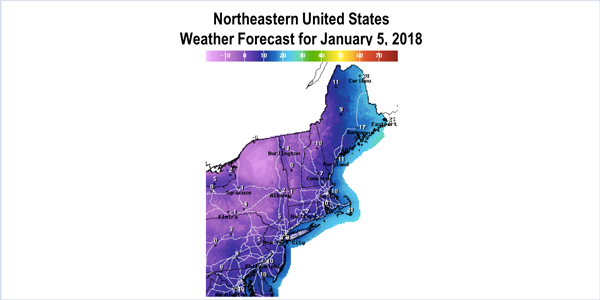By Michael Kuser
The three grid operators serving the East Coast have so far weathered the extended cold snap gripping the region and are preparing to confront another round of plummeting temperatures — along with surging energy demand.
NYISO on Thursday reported strong performance on the 10th straight day of intense cold, with Arctic temperatures forecast for Upstate into the weekend.
“We’ve had no forced outages of the high-voltage direct current transmission system,” Vice President of Operations Wes Yeomans told reporters during a teleconference Thursday afternoon.
“The transmission system between central and eastern New York is fully loaded, as expected, bringing the less expensive energy from the western parts of the state to the high demand zones in and around New York City,” Yeomans said. In addition, the ISO was reaching out to transmission owners in the southeastern part of the state, which was bearing the brunt of a blizzard. (See NYISO Reports Adequate Capacity for Winter.)
Gov. Andrew Cuomo on Jan. 4 declared a state of emergency for the city, Long Island and Westchester County as a strong storm system barreled up the Atlantic Coast. Meanwhile, Upstate saw lake-effect snow, which the National Weather Service expects will be followed by subzero temperatures. A wind chill advisory warned that temperatures could feel as low as -42 F.
PSEG Long Island on Thursday reported that about 3,818 of its approximately 1.1 million customers across Long Island and the Rockaways were without service. As of 4:20 p.m., the utility had restored service to more than 76% of the more than 16,574 customers affected by the storm.
NYISO Executive Vice President Rich Dewey said during the press conference that Albany had endured six consecutive days during which the low temperature fell below zero and the average was 10 F. Such weather is not unusual, but extended periods of it are, and the next couple of days could be the coldest, he said.
“We’re already predicting that we’ll be a couple hundred megawatts above Friday’s projected peak demand of 24,340,” Dewey said. All six nuclear units in the state were online and the storms were keeping the 100 MW of nameplate wind running strong, he said.
Nearly 50% of the New York’s generating fleet is able to switch to oil, which helps grid reliability, Dewey said, adding that operational enhancements made after the 2013/14 cold snap include increased surveys of generators to ensure they have adequate fuel supplies.
Yeomans said the ISO had seen very few generator outages so far and “thankfully no issue yet of a lack of fuel or emission limitations.”
Different generators have different rules and permits with the state’s Department of Environmental Conservation, and “some of the more binding restrictions are 30-day averages, so a generator can be using many of their credits but then turn around and start building them again when the weather turns normal,” Yeomans said.
New England Issues Cold Alert
New England’s bulk power system was also operating reliably on Thursday, ISO-NE spokesman Matt Kakley said.
As a precautionary measure, the RTO on Wednesday issued a Master/Local Control Center No. 2 alert in light of the impending winter storm as well as the expected extreme cold after the storm. The alert requires generation and transmission owners to stop any routine maintenance, construction or test activities on their equipment.
ISO-NE also issued a Cold Weather Watch for Friday and Saturday as forecasts showed the return of extreme cold temperatures seen earlier in the week. The RTO issues a watch when extreme cold weather is in the forecast but it still expects a capacity margin of 1,000 MW or greater. (See New England Grid Prepared for Winter Reliability.) A slimmer capacity margin spurs a Cold Weather Warning, while a Cold Weather Event is called when a margin of less than or equal to 0 MW is forecast, warranting an emergency response.
“Through this weekend, we expect to have sufficient capacity and fuel available to meet demand, barring unexpected outages,” Kakley said.
The cold weather continued to affect wholesale energy prices as well as the types of power plants being used to meet demand. High heating demand for natural gas causes pipeline constraints, resulting in high gas prices, which are driving the need for both oil- and coal-fired generation and boosting clearing prices. As a result, New England Internal Hub prices topped $300 on Thursday.
In general, a snowstorm doesn’t affect forecasted demand for power, unless there are local power outages caused by stormy conditions.
“In New England, we expect to have sufficient capacity and fuel available and expect to be able to weather the storm without running up against significant emissions limits, but concerns remain the same regarding fuel availability and emissions limits throughout this protracted cold spell and the rest of the winter,” Kakley said.
Snow and Ice in PJM
PJM issued a heavy load voltage schedule warning Thursday as a precautionary measure to help maximize power transfer capability and reactive reserve for the evening peak. Despite the warning, the RTO reported having maintained adequate power supplies and operating reserve margins during the cold weather. (See Frigid Weather Tests Grid Operators.)
The RTO reported no concerns with fuel availability and expected no reliability issues through the weekend. Extreme cold temperatures continued across its footprint Thursday, along with snow and ice in its eastern portion.
As of noon, PJM reported the preliminary peak demand for the cold snap as 136,125 MW set the morning of Jan. 3, which was projected to be the peak for the week.
PJM expects lower temperatures heading into the weekend and projects peak load will exceed 135,000 MW Friday morning.






